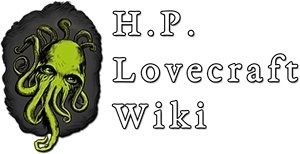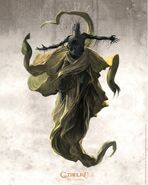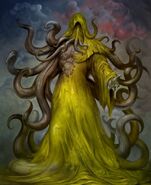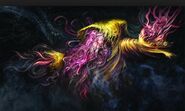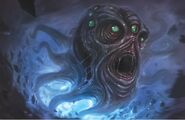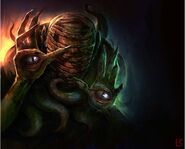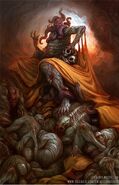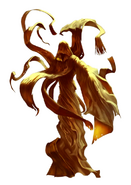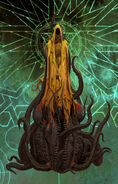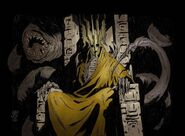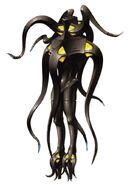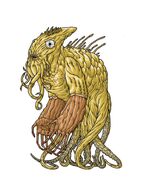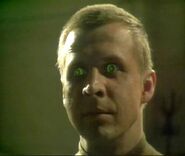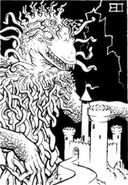| Line 69: | Line 69: | ||
Hastur_(2017_FENIX_Entertainment).jpg|Hastur |
Hastur_(2017_FENIX_Entertainment).jpg|Hastur |
||
Hastur_(Rise_of_Cthulhu).jpg|Hastur (Rise of Cthulhu) |
Hastur_(Rise_of_Cthulhu).jpg|Hastur (Rise of Cthulhu) |
||
| + | Hastur_(Megami_Tensei).jpg|Hastur (Megami Tensei) |
||
67-hastur.jpg |
67-hastur.jpg |
||
Hastur_(BBC).jpg|Hastur, aka Fenric (Doctor Who) |
Hastur_(BBC).jpg|Hastur, aka Fenric (Doctor Who) |
||
Revision as of 04:02, 30 July 2019
Hastur the Unspeakable is a Cthulhu mythos deity. Although the being is most famously associated with H.P. Lovecraft, it is only mentioned in one of his stories, "The Whisperer in Darkness." Originally it was the creation of Ambrose Bierce, whose short story "Haïta the Shepherd" describes Hastur as a god of shepherds. Hastur is the name of a city in the Robert W. Chambers short stories "The Yellow Sign" and "The Repairer of Reputations" which appeared in his short story collection The King in Yellow.
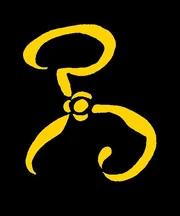
Have you seen the Yellow Sign?
Hastur in the mythos
| “ | I found myself faced by names and terms that I had heard elsewhere in the most hideous of connections—Yuggoth, Great Cthulhu, Tsathoggua, Yog-Sothoth, R'lyeh, Nyarlathotep, Azathoth, Hastur, Yian, Leng, the Lake of Hali, Bethmoora, the Yellow Sign, L'mur-Kathulos, Bran and the Magnum Innominandum—and was drawn back through nameless aeons and inconceivable dimensions to worlds of elder, outer entity at which the crazed author of the Necronomicon had only guessed in the vaguest way.... There is a whole secret cult of evil men (a man of your mystical erudition will understand me when I link them with Hastur and the Yellow Sign) devoted to the purpose of tracking them down and injuring them on behalf of the monstrous powers from other dimensions. | „ | |
| ~ HPL: , "The Whisperer in Darkness" |
Is defined as a Great Old One, spawn of Yog-Sothoth, the half-brother of Cthulhu, and possibly the Magnum Innominandum (AWD). In this incarnation, Hastur has several Avatars:
- The Feaster from Afar, a black, shriveled, flying monstrosity with tentacles tipped with razor-sharp talons that can pierce a victim's skull and siphon out the brain (EXP: "The Feaster from Afar", The Hastur Cycle (2nd ed.), pp. 272–82 [Joseph Payne]).
- The King in Yellow.
The Carcosa Foundation is a Stockholm-based coterie that worships Hastur. (EXP: Anders Fager, "Samlade Svenska Kulter")
Hastur is amorphous, but he is said to appear as a vast, vaguely octopoid being, similar to his half-niece Cthylla.
Behind the Mythos
Inspiration
In Bierce's "Haïta the Shepherd", which appeared in the collection Can Such Things Be?, Hastur is more benevolent than he would later appear in August Derleth's mythos stories. Another story in the same collection ("An Inhabitant of Carcosa") referred to the place "Carcosa" and a person "Hali", names which later authors were to associate with Hastur. In Chambers' The King in Yellow (1895), a collection some of which are horror stories, Hastur is the name of a potentially supernatural character (in "The Demoiselle D'Ys"), a place (in "The Repairer of Reputations"), and mentioned without explanation in "The Yellow Sign". The latter two stories also mentioned Carcosa, Hali, Aldebaran, and the Hyades, along with a "Yellow Sign" and a play called The King in Yellow.
Lovecraft's vision
H. P. Lovecraft read Chambers' book in early 1927 (EXP: An H. P. Lovecraft Encyclopedia) and was so enchanted by it that he added elements of it to his own creations [1]. However it is unclear from this quote if Lovecraft's Hastur is a person, a place, an object (such as the Yellow Sign), or a deity (this ambiguity is recurrent in Lovecraft's descriptions of the mythic entities).
| “ | ... after stumbling queerly upon the hellish and forbidden book of horrors the two learn, among other hideous things which no sane mortal should know, that this talisman is indeed the nameless Yellow Sign handed down from the accursed cult of Hastur—from primordial Carcosa, whereof the volume treats... | „ | |
| ~ HPL , "Supernatural Horror in Literature", discussing "The Yellow Sign" |
- In Chambers' "The Yellow Sign" the only mentioning of Hastur is: "...We spoke of Hastur and of Cassilda..."
So, judging from these two quotes, it is quite possible that H. P. Lovecraft not only recognized Hastur as one of the mythos gods, but even made him so recalling Chambers' book.
Derleth once entertained the notion of calling Lovecraft's mythos the Mythology of Hastur—an idea that Lovecraft summarily rejected when he heard it. [2]
Other Appearances
- George Olshevsky named the nonconvex snub polyhedra after some other Great Old Ones, with the Small snub icosicosidodecahedron as "Hastur".
- Hastur is one of the main characters, along with Nyarlathotep and Cthugha, in the anime, Haiyore! Nyaruko-san.
- Murcielago, Japanese ongoing manga, has protagonist by the name of Kuroko. Kuroko is translated to 'black lake' and is a reference to Lake of Hali where Hastur resigns.
References
- (1998) "Hastur". The Encyclopedia Cthulhiana, 2nd ed. Oakland, CA: Chaosium, p. 136–7. ISBN 1-56882-119-0.
- (2005) The Lovecraft Lexicon (1st ed.). Tempe, AZ: New Falcon. ISBN 1-56184-129-3.
- (1997) The Hastur Cycle (2nd ed.). Oakland, CA: Chaosium. ISBN 1-56882-094-1.
